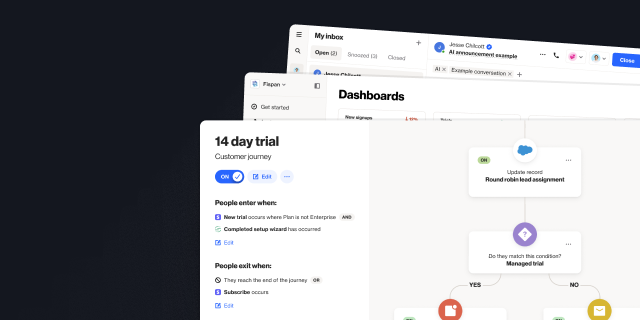8 things custom fields will tell you about your customer's behavior
Outline
- Introduction
- What are custom fields?
- 8 things custom fields can teach you about your customers
- Setting up custom fields in Ortto
- Final word
More like this:

No two businesses are exactly the same. That’s why custom fields are such an important feature of your customer data platform — they allow you to manage and track data points that are important to your business.
In this blog, we’ll be exploring how custom fields can help you create more robust people and organization records, and how these fields can benefit your business. We’ll be providing a wide range of use cases as inspiration, but keep in mind this is just the tip of the iceberg — the possibilities are endless.
What are custom fields?
Custom fields are associated with person and organization records, and they allow you to track any system, custom, and data source fields.
In Ortto custom fields can be automatically updated by connecting them to custom activities, or you can also set up journeys to automatically update the field value when an activity occurs. They can also be added to the about section of the people or organization record, where you can manually update the information if required and see any associated activity in the activity feed.
8 things custom fields can teach you about your customers
Total value of discounts a customer has received
Marketing automation is a wonderful thing. It allows you to quickly and easily send discount codes to customers when they’ve lapsed, abandoned a cart, or signed up for your newsletter. But sometimes all that automation, in addition to discount codes shared by customer service representatives, can result in a total discount value that exceeds what you intend to send.
By creating a custom field for aggregate discount value, you can add a ‘Total value of discounts’ field to your customer’s profile. This means, next time the customer is asking for a discount, your customer service team can check in to see a snapshot of the total value of discounts your customer has received.
This can also be useful if you’re a B2B supply company that offers discounts on bulk products. If you have multiple people associated with one organization, you can use the organization-level custom field to keep track of the total discount value offered to the organization.

2. Store, clinic, or office preference
If you have physical stores, clinics or offices, you can create a custom field that shows your customer’s location preference.
For example, let’s say your company is a medical center with locations across the five boroughs of New York City. It’s likely you will have multiple locations throughout the city and your patients will most frequently attend a location near to their home or office. With a custom field, anyone across the organization can quickly see your patient’s location preference to make the booking process seamless.
You can also use this information to ensure the right customers receive important updates about changes to opening hours, staffing arrangements or protocols at specific locations.
3. Total logins or user sessions
If you’re a SaaS company, getting a snapshot of the total logins or user sessions for any individual or organization can help you quickly identify which customers are highly engaged, and which may be lapsing.
This information may also help you determine who in any given organization is using the product most frequently. For example, it could be a marketing ops professional who is doing the heavy lifting and, when it comes time to reach out to someone about participating in a case study, you’ll know who has the most hands-on experience.

4. Last in-store visit date and average time between visits
Custom fields can help you get a better sense of your customer’s shopping habits. You could create two custom fields, one for last in-store visit and one for average time between visits, and add these data points to a dedicated section in the individual’s records.
With this information, you can start to anticipate when a customer is due to come in store, and send them relevant information or offers around that date. This can be especially valuable if you are a company offering a service. For example, perhaps your customer has been coming in at least once a month to have a massage. If you can see their last visit was over two months ago, you could send them an offer to entice them to come in and keep up the good habit.
5. Total number of loyalty points
If you have a loyalty program, tracking the total number of loyalty points on an individual or organization level is essential, especially if those point numbers are associated with different loyalty tiers or offers.
Use a custom field to track the total number of loyalty points and ensure this is added to your customer’s profile. You can choose to add this right at the top so that any customer support agents can immediately see if they are speaking to a highly-loyal and valuable customer.
6. Business type or category
If you’re a B2B or SaaS company like Ortto, it’s likely you have customers in industries including B2B, SaaS, ecommerce, and B2C. Often, the business type or category is critical information to store.
You can set up a custom field for a business type or category in two different ways. In one case, you may have a self-selected category and in another, you could have a field for categories that were completed by a data enrichment program like Clearbit.
In both cases, you can add this information at both an organization and people level.

7. Reason for churning or unsubscribing
Churns and unsubscribes are never celebrated, but they can provide you with valuable information about the customer journey and your offering. If you ask your churning or unsubscribing customer to indicate the reason for leaving, you can use this information in a custom field attached to your records.
With this information, you can then take steps to entice your customer to come back. For example, if the reason is price, you could offer them a discount. If the reason is customer support lacking, you could offer them a dedicated support manager. You can also create reports to keep track of the churn reasons that occur most frequently.

8. Average order value
Some customers shop infrequently, but with a higher-than-average basket size. Without tracking average order value, you run the risk of overlooking these valuable and loyal customers.
Set up a custom field for average order value to keep track of your high-value, low-frequency customers.
Setting up custom fields in Ortto
You can set up custom fields in individual people records or in setup. If you choose to set your field up in setup, you will be able to keep track of changes to the field so you can report on them and, over time, gain valuable insights into your customer’s behavior and the health of your business. To get started, follow these steps:
Go to Setup
Go to Customer Data
Click Fields
Click + Add custom field and select either a people or organization field
Give your field a name and type, and choose whether you want to track field activity

From here, there are three ways to keep your fields up to date:
If the field is related to a custom activity that you have not set up yet, you will need to set up a related custom activity in order for the data to be automatically updated. If, when setting up your field, you selected to track activity, a connected custom activity will be automatically created as a draft in the Activities section of your CDP. From there, you can set your custom activity up by following the instructions. See here for more on how to set up custom activities.
If the field is not related to a custom activity, you can set up a simple journey to update the field value whenever the relevant activity occurs.
You can manually update fields in the people or organization record.
Final word
The more you know about your customer, the better you can serve them. With custom fields, you can track the data points and information that is most important to your business. Sign in or sign up to Ortto to get started today.


“We were looking for a solution that was really easy to use, didn’t require a tech team, and would have a robust integration with Salesforce so we could trigger sales communications in a smarter way. Nobody else out there has what Ortto has.”

Try Ortto today
Build a better journey.

Product
Pricing
Solutions
Features
About
Resources
Ortto for
Templates
Integrations








